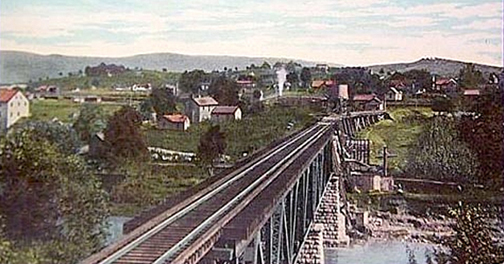A March 24, 1940 Johnson City Press-Chronicle newspaper clipping alleges, “Bluff City Probably Had Section’s Pioneer Plant – Hat Factory Operated in Sullivan Before Area’s Present Industrial Centers Developed.”
Johnson City and other nearby cities had over the years become fertile industrial centers. Long before Henry Johnson built a water tank and depot in preparation for the emerging East Tennessee, Virginia and Georgia Railway, a hat factory was in operation near Bluff City close to Thomas’ Bridge. Oliver Taylor corroborates this fact in his 1909 book, Historic Sullivan. He wrote that Edward Anderson operated the pioneer plant producing what he called a “good serviceable hat.”

Virginia and Southwest Railroad Bridge in Bluff City
Taylor also noted that the Sparger and Byrd mills at Bristol and the Prather mills at Bluff City, erected in 1874-75, survived only a few years because of high freight charges. The tobacco factories operated by Reynolds at Bristol and Prather at Bluff City also became casualties after selling their goods on credit and not getting paid on a timely basis.
Colonel Sam L. King of Bristol maintained that James King, his great-grandfather, and William Blount, first territorial governor of Tennessee, engaged in iron manufacturing between Bristol and Bluff City shortly after the Revolutionary War. Reportedly, cannon balls used by General Andrew Jackson at the Battle of New Orleans, the final major battle of the War of 1812, were made at the furnace. It was located at the mouth of Steel’s Creek adjacent to a discontinued division of the Southern Railroad.
The locale now known as Bluff City was among the oldest trading settlement in the state. As early as 1777, the commissioners of Washington County, Virginia, ordered a road built from Abingdon to Choate’s Ford (Bluff City). Choate was a notorious horse thief and Indian trader, according to Taylor’s research.
Over time, the town became Middletown (situated between Abingdon and Jonesboro), Union, Zollicoffer (so named to honor Confederate General Felix Zollicoffer), Union (again) and finally Bluff City on July 1, 1887. The town acquired more name changes than any city in Tennessee. The current designation is derived from the steep rocky bluffs on the Holston River along one side of the town.
Davy Crockett’s father, John, lived in the vicinity of Bluff City before moving to the Limestone settlement in Washington County, Tennessee. Saint Joseph Company, producer of a well-known brand of drug products, originated in Bluff City. In 1805, a settler could purchase a quarter-acre plot of land for $82.
In 1872, Bluff City’s first newspaper, the Landmark, started publication with W.D. Pendleton as proprietor and Major B.G. Vance as editor. In 1878, the paper moved to Blountville, the county seat. It was claimed by many authorities to be the second oldest town in the state behind Jonesboro.
Another paper, the Central Star followed a few years later. B.L. Dulaney, forefather of Mrs. Jay Gump of Johnson City and N.J. Phillips, owned it. Phillips later became the sole owner and moved the paper to nearby Newport in Cocke County. The last newspaper to be put out in Sullivan, as noted by Oliver Taylor, was the Sullivan County Developer in 1908 with W.D. Lyon serving as editor.
My column photo shows the Virginia and Southwest Railroad Bridge in Bluff City. It was originally planned to haul iron ore from Northeast Tennessee, but instead became a major transporter of farm and timber products.
